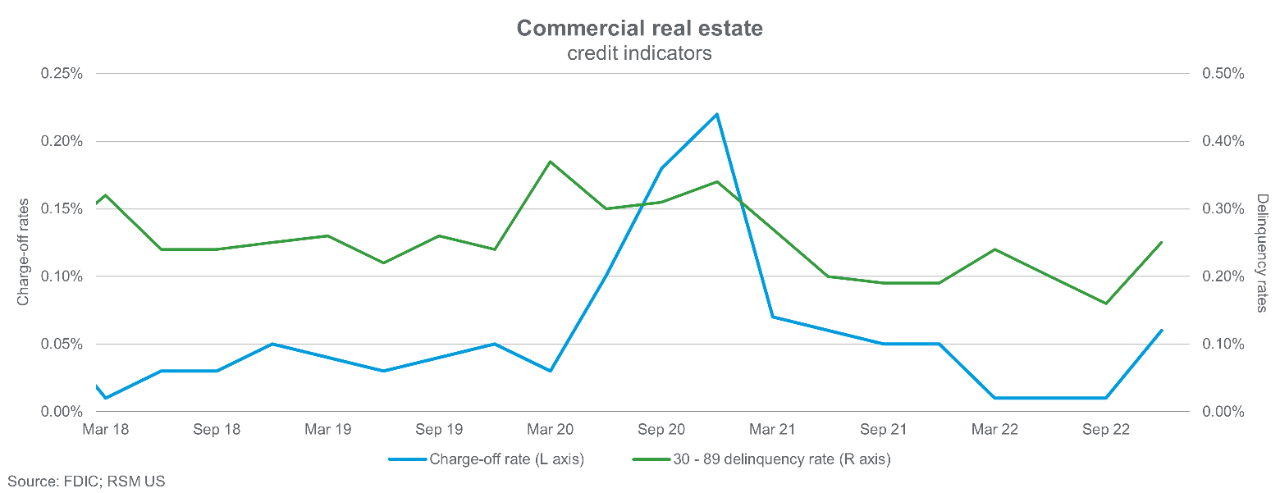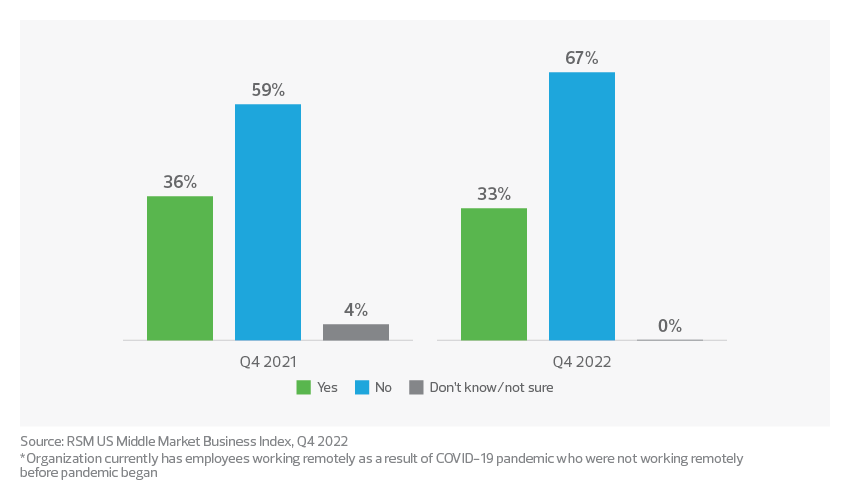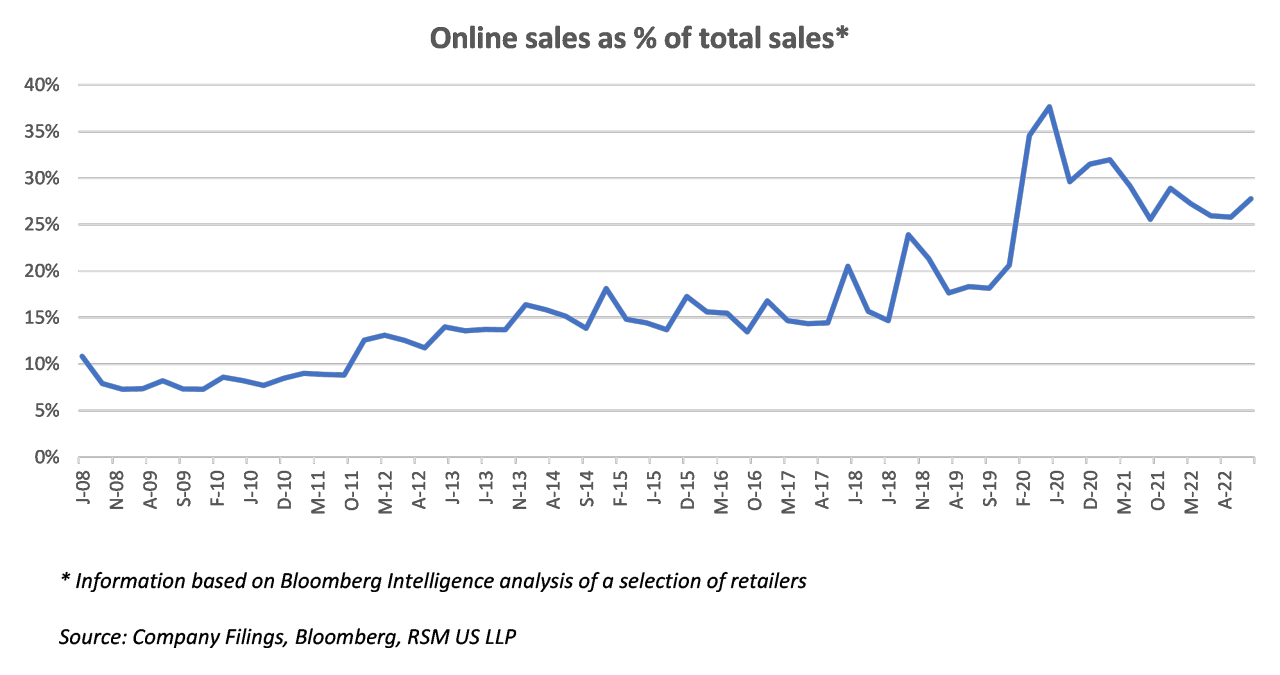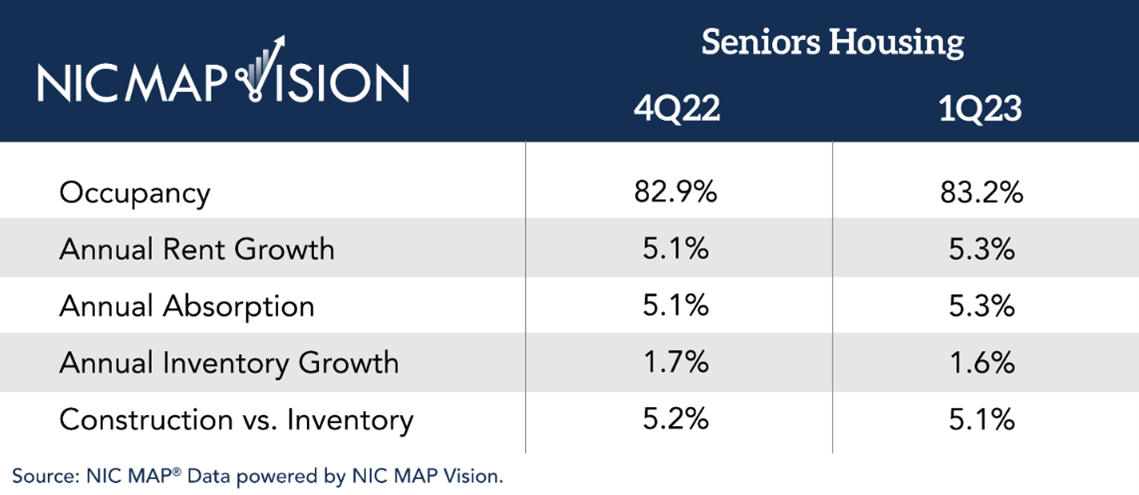ARTICLE | May 02, 2023
Lenders continue to digest the long-term implications of distress in the banking industry precipitated by the recent failures of Silicon Valley Bank, Signature Bank and now First Republic Bank as the fallout focus shifts to potential trouble spots.
Signs point to increasing credit risk in commercial real estate loan portfolios, as recent skittishness around lending has compounded existing concerns. The CRE sector was already under pressure due to pandemic-induced trends such as the shift to remote and hybrid work that resulted in more unused commercial space, and Federal Reserve rate increases totaling 4.75% over the past year. Rate increases have made refinancing commercial property loans onerous, requiring a significant increase in debt or a capital contribution to support new loan-to-value ratios.
These trends mark a reversal from the positive environment for commercial real estate seen for most of the past decade. That environment was characterized by low interest rates and favorable market trends that fostered growth in CRE lending, especially at regional and community banks.

Now, with an estimated $1.4 trillion in CRE loans coming due in 2023 and 2024, according to data from the Mortgage Bankers Association, bankers are asking: “Where in my CRE portfolio will the credit cracks begin to form?”
Below, we take a look at three CRE sectors that may be high on their list.
Commercial office space
The shift to remote and hybrid work has ushered in an era of change and uncertainty for commercial offices, which had long been considered safe assets with steady cash flows. In April 2023, office occupancy was hovering at just 45% nationally, compared with nearly 100% in March 2020, as measured by property security firm Kastle Systems. Those figures are strong evidence of the entrenchment of hybrid work.
In the fourth quarter of 2022, 33% of middle market executives responding to an RSM survey reported having employees working remotely due to COVID-19 who were not doing so before. That is only slightly below the 36% who responded similarly to the same question a year earlier when COVID-19 infections were higher.

A flight to quality has ensued, and Class A office properties have become more attractive. Tenants seek amenity-rich spaces in convenient locations with flexible designs and new technologies to lure existing workers back and to entice new hires. Meanwhile, many existing office tenants are attempting to downsize, leading landlords to seek new tenants—sometimes outside the office category—to fill the void. Recovery in the office sector hinges on how well property owners can navigate rising interest rates, reduced absorption and declining market rents.
Assessing office property risk
The financial health of an office building is primarily measured by its weighted average lease life—that is, the length of time that building will be leased and produce steady cashflows. A weighted average lease term of greater than five years is considered positive in the face of today’s rising interest rates. This time frame allows rates to come back down, alleviating pressure on cashflows.
The maturity date of underlying debt is also an important consideration, with loans coming to maturity in the near-term presenting the greatest challenges for landlords. Lending for office properties has stalled and efforts to extend loan terms or negotiate debt are now closely scrutinized by bank underwriters. Office landlords and lenders alike run the risk that their assets will revert to the bank. However, lenders are not skilled at managing offices, and are more likely to seek additional equity to work out problematic loan terms in lieu of bringing an office property onto their books.
Finally, tenants should also be scrutinized. Tenants that have established clear hybrid work policies and maximize existing space with long-term leases dating to before the start of the pandemic in 2020 are typically a safer bet.
Alternatively, those occupants with limited hybrid work policies and shorter time remaining on current leases pose greater risk to the landlord; they may leave at lease expiration or seek to downsize their space at maturity. While keeping a tenant at the property is preferred, amended lease terms for a smaller space at a lower rate reduces landlord cashflow—not an ideal scenario for any landlord, but more challenging in the current rising interest rate environment.
Retail
Retail space is an important part of the commercial real estate sector, with diverse properties including shopping centers, strip malls and standalone stores.
Rising interest rates, in addition to creating challenges for fixed-rate loan agreements, make it more expensive for the retailers leasing space to borrow money. This puts greater focus on retailers’ decisions to open or redesign stores, with some opting exclusively for e-commerce channels. While the pandemic initially accelerated a progressive shift to online shopping, over time consumers’ desire for in-store retail experiences has shown signs of returning. The current high interest rate environment may provide another strong catalyst for certain retailers to boost e-commerce.

Rising interest rates can also curtail the ability of landlords to refinance their properties, reducing property valuations and making it more difficult for landlords to sell.
Certain subsectors of retail real estate such as destination malls and regional strip malls will likely face greater vulnerability than standalone stores or retail centers with high-traffic anchors such as grocery chains, especially as many department stores reevaluate their market strategies and begin to transition away from malls to self-owned real estate.
Malls large and small
Large-format malls remain one of the most vulnerable retail real estate subsectors, having struggled in recent years to attract tenants and shoppers alike amid the onset of e-commerce and the rise in experiential retail centers, such as sports stadiums with adjacent restaurants and shopping. Slowing foot traffic and lower profitability of mall-based retailers have led to the significant reduction of retail’s physical landscape, including store closures by Nordstrom and Macy’s, and bankruptcies of stalwarts Sears, JC Penney, Lord & Taylor, Neiman Marcus and Bed, Bath & Beyond.
With reduced demand for space, mall landlords have also seen vacancy rates rise, creating an additional burden as they deal with declines in revenue and rising costs, a recipe for hard times.
Strip malls face additional vulnerability in the form of tenant credit risk. Typical strip mall tenants tend to be small businesses, including retailers, that focus on the needs of the surrounding community and lack the financial resources of national chains. These tenants present greater financial risk to landlords, especially during economic downturns when their customers may look to cut discretionary spending. Their reduced revenue translates to greater likelihood of non-payment on leases and can perpetuate the inability of landlords to refinance.
Senior living
Senior living, which includes assisted living and retirement communities, was an investor draw for the better part of the past decade, promising solid returns as the baby boomer generation aged. More recently the sector has lost its luster, due in large part to pandemic-related challenges including health and safety considerations, staffing shortages and the decision by more elderly people to age in place or move into multigenerational living with family.
During the height of the pandemic, senior housing occupancy dropped quickly, as senior facilities faced high rates of COVID-19 fatalities and a shrinking labor pool. Occupancy in private-pay senior housing bottomed out at 77.9% in the second quarter of 2021, according to data aggregated by the National Investment Center for Seniors Housing & Care. In the first quarter of this year, occupancy had risen to 82.9%, but still lagged a pre-pandemic high of 87.2% in the first quarter of 2020.

A reluctance to retire or move
Rising inflation and the economic slowdown have put additional pressure on this asset class. Financial concerns are clearly adding to seniors’ unwillingness to retire, as waning pensions, a lack of retirement savings and rising medical costs prompt many seniors to work longer than they had planned. Meanwhile, beneficial new work conditions such as remote and hybrid work make it more attractive to continue working.
In 1980, 38% of the U.S. workforce could look forward to a pension; in 2020, that figure had dropped to 15%, according to the Bureau of Labor Statistics. At the same time, retirement savings such as 401(k) plans have not prepared boomers to leave the workforce; the median savings in those plans were only $202,000, according to data released in April of 2022 from the Transamerica Center for Retirement Studies.
The pandemic has also resulted in more children moving between in-person and remote learning, creating the additional need for in-home childcare. Some grandparents are stepping up to fulfill that need through mutually beneficial multigenerational living arrangements. In addition, recent improvements in telehealth now make it possible for more seniors to postpone moves to environments offering in-person care.
Risk mitigation steps for bankers
There is no magic formula to avoid defaults in commercial real estate, but these proactive measures can help lenders mitigate risk:
- Review portfolios. Review concentrations of loans in commercial real estate by category, then break them down by maturity and refinancing risk. Consider stress testing for both near-term and long-term refinancing. Establish communications with borrowers to work through financing challenges sooner rather than later.
- Set guidelines. Establish guidelines around refinancing protocols, taking into consideration when to require additional equity, how far to consider extending amortization, and potentially receiving a lower interest rate margin in exchange for up-front fees.
- Understand current valuations. Obtain up-to-date details about property status from landlords and have a clear picture of comparable valuations in the market.
- Get to know borrowers better. Push for more information about borrowers around financial health and liquidity. Have a clear understanding of any contingent liabilities that could impact on their ability to support the bank’s loan.
Justin Freeman, Tim Aurrichio, Mike Graziano and Rahul Vithani contributed to this article.
Questions or Want to Talk?
Call us directly at 972.221.2500 (Flower Mound) or 940.591.9300 (Denton),
or complete the form below and we’ll contact you to discuss your specific situation.
This article was written by Brandon Koeser, Nick Grandy, Angela Kramer, Sarah McKevitt and originally appeared on 2023-05-02.
2022 RSM US LLP. All rights reserved.
https://rsmus.com/insights/industries/real-estate/commercial-real-estate-high-among-bankers-ongoing-debt-concerns.html
RSM US Alliance provides its members with access to resources of RSM US LLP. RSM US Alliance member firms are separate and independent businesses and legal entities that are responsible for their own acts and omissions, and each are separate and independent from RSM US LLP. RSM US LLP is the U.S. member firm of RSM International, a global network of independent audit, tax, and consulting firms. Members of RSM US Alliance have access to RSM International resources through RSM US LLP but are not member firms of RSM International. Visit rsmus.com/aboutus for more information regarding RSM US LLP and RSM International. The RSM(tm) brandmark is used under license by RSM US LLP. RSM US Alliance products and services are proprietary to RSM US LLP.

KHA Accountants, PLLC is a proud member of RSM US Alliance, a premier affiliation of independent accounting and consulting firms in the United States. RSM US Alliance provides our firm with access to resources of RSM US LLP, the leading provider of audit, tax and consulting services focused on the middle market. RSM US LLP is a licensed CPA firm and the U.S. member of RSM International, a global network of independent audit, tax and consulting firms with more than 43,000 people in over 120 countries.
Our membership in RSM US Alliance has elevated our capabilities in the marketplace, helping to differentiate our firm from the competition while allowing us to maintain our independence and entrepreneurial culture. We have access to a valuable peer network of like-sized firms as well as a broad range of tools, expertise, and technical resources.
For more information on how KHA Accountants can assist you, please call 972.221.2500.

